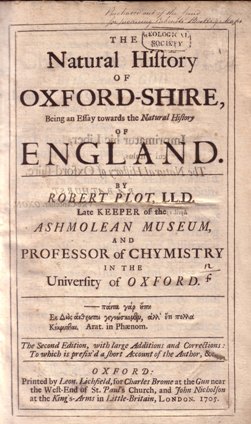 Picture: The title page of the second edition of Plot’s book, in the Society’s collection.
Picture: The title page of the second edition of Plot’s book, in the Society’s collection.
Although Plot’s characterisation of the bone as human was incorrect, his speculation that it was “at least of some other Animal” was spot on. The bone, which Plot noted had come from a quarry at Cornwell, near Chipping Norton in Oxfordshire, was later recognised to be the lower part of a thigh bone of the dinosaur Megalosaurus.
A seemingly modest man, Plot would probably have been horrified to learn that in 1763, Richard Brookes, an English physician and author, labelled this same illustration as Scrotum humanum when he included it in his own six- volume opus: A System of Natural History. This unfortunate mistake resulted from a combination of sloppy scholarship and printers’ errors. Brookes took his information from the second (1705) edition of Plot’s book (picture) where inclusion of an expanded text meant that paragraphs were re-numbered, but the Plates were not – leading to some confusion when it came to captions.
Palaeontologists have been having fun with this printing error ever since. In the late 20th Century geologists Bill Sarjeant and Beverly Halstead suggested that Brookes’s epithet Scrotum humanum should be given priority over Megalosaurus, the name assigned in 1824 by William Buckland, first Reader in Geology at Oxford and the first to publish a name for a dinosaur. When the suggested name-change was overruled by the International Commission for Zoological Nomenclature, palaeontological pornographers might have been a bit disappointed. But revisionist historians may still have a case. Even though Plot may have lost the plot so far as the bone identification goes, it could be argued that he beat William Buckland to the discovery of dinosaurs.
*Nina Morgan is a geologist and science writer based near Oxford.
Acknowledgment
The idea for this vignette comes from a lecture entitled ‘Plot and the Big Bone’, given by Philip Powell of the Oxford University Museum of Natural History in November 2010, as part of an afternoon of talks about Robert Plot held at the Museum of the History of Science in Oxford to mark the 350th anniversary of the Royal Society. Other sources include:
When Scrotum Humanum walked on Earth by Patrick Wyse Jackson, Lost magazine, May 2007 – No 15 [
www.lostmag.com/issue15/paleontology.php?] and
A brief history of dinosaur paleobiology, by Michael J Benton in Paul, G.S. (ed) The Scientific American book of dinosaurs, St Martin’s Press, New York, 2000, pp. 10-14 [
http://palaeo.gly.bris.ac.uk/Essays/dinohist.html]
- If the past is the key to your present interests, why not join the History of Geology Group (HOGG)? For more information and to read the latest HOGG newsletter, visit: www.geolsoc.org.uk/hogg, where the programme and abstracts from the Conference on Geological Collectors and Collecting are available as a pdf file free to download.